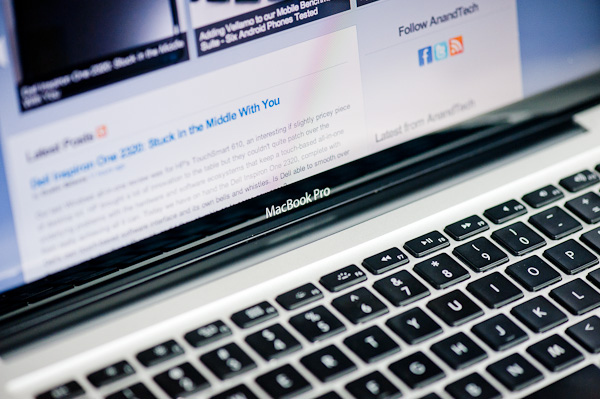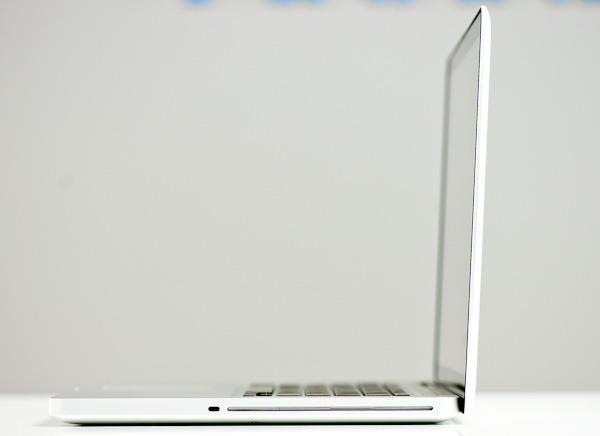Apple 15-inch MacBook Pro (Late 2011) Review
by Anand Lal Shimpi on November 17, 2011 5:10 PM EST- Posted in
- Mac
- Apple
- Intel
- MacBook Pro
- Sandy Bridge
- Laptops
Final Words
While I had a hard time recommending the base 15-inch MacBook Pro to users earlier this year, with the GPU upgrade I'm pretty happy with the $1799 configuration. It is pricey for sure, but if you can only have one Mac in your life and you like performance, it is probably the one to get.
The MacBook Air is nice but for demanding workloads it's not enough. The iMac is fast, but I'm not a fan of lugging around a 27-inch display with me wherever I go. The 15-inch MacBook Pro is honestly the best of both worlds. Obviously there are cheaper PC alternatives if you just need affordable compute, I'm speaking only to those users who have their sights set on something running OS X.
The only changes I'd make to the system are an upgrade in display resolution and the addition of an SSD. Both are options that Apple offers, and with the latter you can always handle that upgrade on your own.
At some point Apple will have to outfit these things with SSDs standard, similar to the MacBook Air. There's such a huge difference in user experience that it only makes sense to, the question is when?
For a while now we've heard rumors of a thinner, redesigned MacBook Pro without an optical drive. Removing the optical drive alone isn't enough to significantly decrease the thickness of the machine, Apple would have to move away from the 2.5" HDD form factor as well. Given that there are no reasonable performing HDDs in a smaller form factor, one would assume that if and when Apple removes the optical drive from the MacBook Pro, it will also remove the hard drive.
Ivy Bridge would be an interesting time to make such a drastic move, as Intel's 22nm process should be able to significantly reduce power consumption. Although the time may be right from a processor perspective, I wonder whether the MacBook Pro audience would be fine with only 128GB or 256GB of storage.
There is of course another option: expand the MacBook Air line with a larger (thicker?) 15-inch model. The trick here would be cramming a 35W quad-core chip into the system, otherwise it just becomes a 13-inch MBA with a bigger screen. That's where the thicker comment comes into play. Currently the MacBook Air only has to worry about dissipating 17W from the CPU, which includes the GPU. The 15-inch MacBook Pro however has a 45W quad-core CPU and a discrete GPU. Ivy Bridge will significantly increase integrated graphics performance, but not enough to truly eliminate the need for a discrete GPU. I suspect for Apple to do the ultra thin 15-inch MacBook Pro the right way it would have to wait until Haswell, where integrated graphics performance is supposed to be much better.
Of course all of this is speculating out loud, anything (or nothing) could happen. If you need a system today, the upgraded MacBook Pro line makes an an already great system a better value. If you can wait, Ivy Bridge will likely be very good for notebook users in about 6 - 8 months.
That's the downside to Intel's tick-tock cadence. When the ticks and tocks are major, there's almost never a good time to buy. Ivy Bridge will significantly reduce power consumption and improve GPU performance and then there's Haswell...
The next two years aren't going to be easy on anyone's wallet.












101 Comments
View All Comments
ananduser - Sunday, November 20, 2011 - link
OpenGL drivers are also better and actually up to date compared to OSX, you keep to omit that.Back in 2011(your link is a test from 2008) there are Win7 ultrabooks(that come to mind) that offer at least comparable battery life with the most recent Air. Anand should use desktop Flash browsing in his browsing tests so as to provide more realistic battery life patterns.
KoolAidMan1 - Sunday, November 20, 2011 - link
Are you really being this nitpicky? When I talk about video drivers being more up to date in Windows, I figure that both DX and OpenGL can be inferred. The only reason I wasn't as specific is because nothing (not even Carmack's RAGE) uses OpenGL in Windows these days. I didn't think it was even worth mentioning given that DirectX is the standard, so much so that even he threw in the towel.If you can't infer that then maybe I need to spell everything out for you from now on. Either way it doesn't change my core criticisms that video drivers from GPU manufacturers are more up to date than the ones that Apple puts out much less frequently on their own.
As for recent Win7 ultrabooks, I expect that the battery life results would be similar with the same hardware as the Air given that Windows 7 and Vista are still roughly in line with each other. Win7 is actually marginally worse in terms of battery life if I'm not mistaken.
Either way, the test is from 2008 but I don't expect the results to be any different on similar hardware given that Win7 hasn't yielded any improvements in that area.
Regarding tests with and without Flash, he's always very clear when he's having it off or on. In the case of the 2008 test it wasn't mentioned, so I have to assume that Flash was used in both tests.
You seem to be desperately looking for excuses.
ananduser - Sunday, November 20, 2011 - link
I was under the malevolent influence of your nick :).The Verge's and Engadget's recent ultrabook reviews yielded similar battery life across the board. One exception is that of Sammy's Series 9, but that is a significantly older part. Toshiba's Protege actually has the highest battery life out of the pack(Air included). So NO, things have changed since 2008, and your axiom is wrong.
Why would I care so much to look for excuses ?
Death666Angel - Friday, November 18, 2011 - link
"it would have to wait until Haswell, where integrated graphics performance is supposed to be much better."I still hope that AMD can deliver good CPU performance within the next year or two. Do you think Apple will ever bother with AMD, even if they become competitive again?
Vepsa - Friday, November 18, 2011 - link
I really want one of these. However, I want to know what you guys do with your review machines too. If you don't have to send this one back, I'll take it ;)TheGeoff - Friday, November 18, 2011 - link
Cool. Glad to hear they addressed that.MobiusStrip - Friday, November 18, 2011 - link
At least you can now GET the matte screen on the 15" (for an extra $150, or $50 more than the optional higher-res screen), although it's still inexplicably not available on the machines that are most likely to leave the house: the 13" MBP and the Airs.After many, many hours working with matte and glossy screens under all lighting conditions, you'll realize: glossy screens suck. This asinine fad is the biggest regression in computing since... what?
It's time that reviews call this out instead of and make it a marketing liability that Apple and others can't ignore, instead of (yes, here it comes) GLOSSING OVER IT.
tzhu07 - Monday, November 21, 2011 - link
Yes, totally. I don't understand the glossy trend. When I was in the market for a 2560 monitor, I had to immediately eliminate the Apple 27" display because of the glossy screen. They lost $1,000 from a customer by default.NEC ended up with my money for the PA271W.
MadMacMan - Friday, November 18, 2011 - link
Wait for Haswell? What the hell? You might as well never get any notebook or computer of any kind for that matter, as something better is always on the horizon. Even Ivy Bridge is 6-8 months too far into the future as far as I'm concerned.I just discovered this site and spent four hours reading reviews and benchies last night. lol...It works so well for me because Anand thinks like me when it comes to wanting your cake and eating it, too, with using a 15" or 17" MacBook Pro along with a 27" ThunderBolt / (LED) Cinema Display. Right down to using the Magic Trackpad instead of a mouse. haha...that's awesome!
Well, this setup has really only been possible on a more serious level since Sandy Bridge and ThunderBolt. It is about to get even sweeter once there are ThunderBolt adapters and devices coming out, such as the Sonnet TB --> ExpressCard/34 adapter and PCIe expansion enclosures that will allow multiple full-length PCIe cards to be added to a *laptop*, something that still requires a Mac Pro today.
Finally, I actually wanted to add something to this review that wasn't mentioned and that has been a thorn in my eye with the 2011 (Early as well as Late). The 15" and 17" MBP's SATA III implementation STILL doesn't work in the optical drive bay! I have two OWC Mercury EXTREME Pro SATA III (6Gbps) SSD's that I used to get upwards of 900MB/s (and over 100,000 IOPS) in a Mac mini server before I switched (back) to this (laptop+display) model. Even more infuriating is the fact that the 13" MBP works just fine with SATA III SSD's in *both* bays! Grrr! Yes, I realize that Apple not only didn't advertise the fact that SATA III drives can be used since its Early-2011 MBP models, but they haven't even so much as mentioned it in any of its marketing materials. Whatever...I'm back down to 550MB/s using just one of my solid state drives. (P.S.: Yes, I know, first world problem...)
umesh - Saturday, November 19, 2011 - link
Has anyone noticed that the second table above reads "Apple 15-inch Late 2011 MacBook Pro CPU Comparison", whereas the listed processors all belong to the EARLY 2011 MBP models?